When exploring Italian food markets, greet vendors politely with “Buongiorno” or “Ciao” and show genuine interest in their products. Respect local customs by handling samples with small utensils and asking permission first. Pay attention to authentic products marked with regional labels, and don’t forget to carry cash for smooth transactions. Enjoy regional specialties like arancini and fresh focaccia, and keep an eye out for tips that help you get the most authentic experience.
Key Takeaways
- Greet vendors politely with “Buongiorno” or “Ciao” and build personal connections for an authentic experience.
- Ask permission before sampling food, use utensils or toothpicks, and limit tasting to show respect.
- Carry cash and handle transactions with politeness, using phrases like “Il conto, per favore” or “Posso pagare con carta?”
- Look for regional labels and certifications on products, and try local specialties like arancini, focaccia, panelle, and cannoli.
- Participate actively in tastings, explore various stalls, and engage with vendors for recommendations and cultural insights.
Understanding Local Shopping Customs in Italy
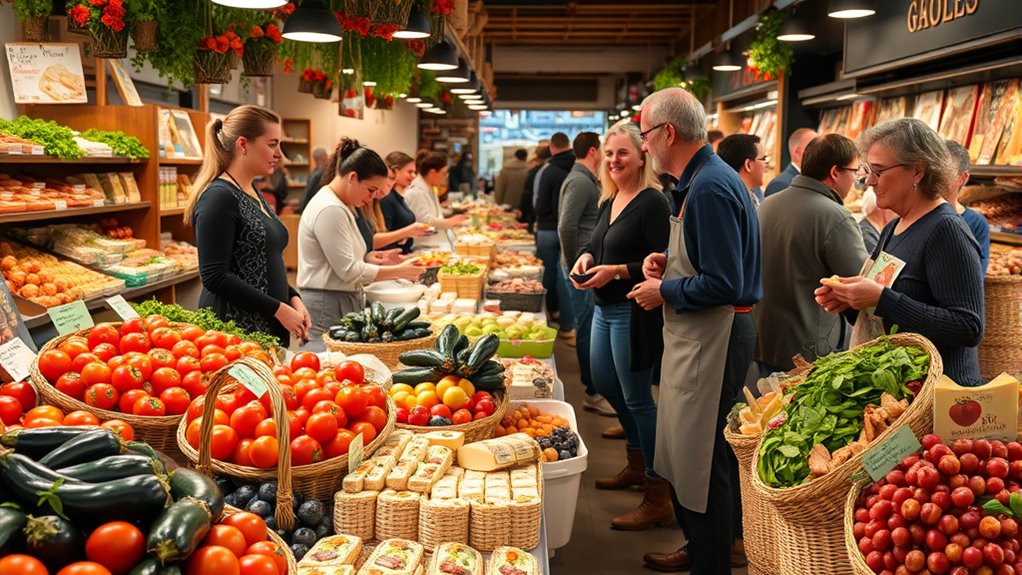
Understanding local shopping customs in Italy can greatly enhance your market experience. Italian markets have a rich history rooted in community and tradition, which influences how vendors and customers interact. Knowing that markets often evolved as hubs for local trade helps you appreciate the importance of building genuine vendor relationships. Vendors value familiarity and personal connections, so taking the time to chat and show respect fosters trust and better service. Remember, bargaining isn’t common in most markets, but engaging politely and showing appreciation for their products creates a positive atmosphere. By understanding the market’s history and respecting these customs, you’ll enjoy a more authentic experience and perhaps even discover hidden culinary treasures.
How to Greet Vendors and Engage Respectfully
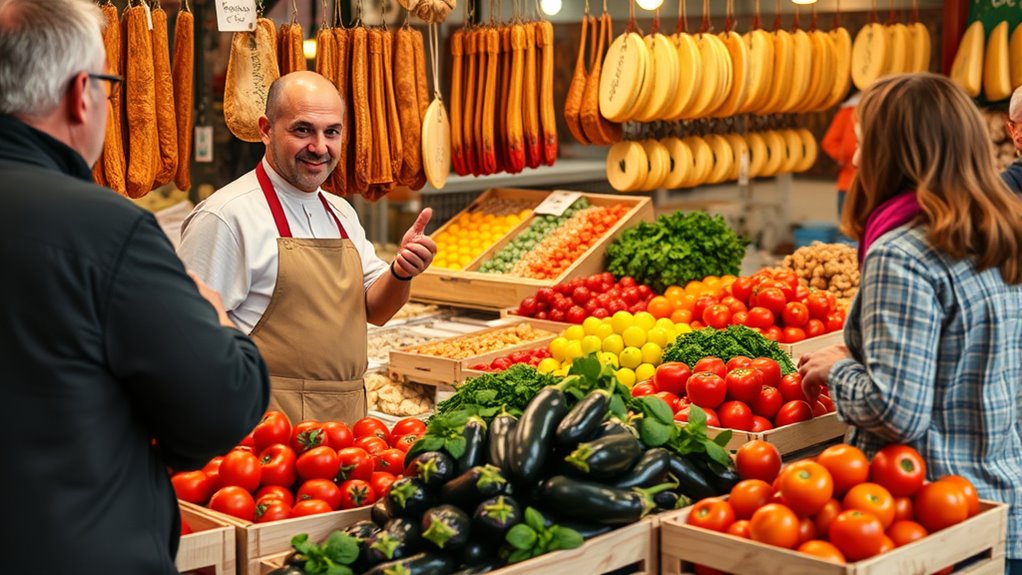
When you step into an Italian market, greeting vendors warmly sets a positive tone for your interactions. Use friendly greeting gestures like a simple “Buongiorno” or “Ciao” to show respect and friendliness. Maintaining eye contact and offering a genuine smile demonstrates respectful communication and helps build rapport. Address vendors politely, using “Signore” or “Signora” when appropriate, especially if you don’t know their names. Avoid rushing or sounding impatient; patience is appreciated. Listening attentively and responding with appreciation encourages a friendly exchange. Remember, respectful communication goes beyond words—your body language and tone matter. A warm, courteous approach shows you value their work and creates a more enjoyable shopping experience for both of you. Being aware of cultural customs and local etiquette can further enhance your interaction and show your appreciation for local traditions. Additionally, demonstrating awareness of Deaf Vibes communication techniques, such as visual cues and respectful gestures, can foster more inclusive and positive interactions. Recognizing the importance of company values in local businesses can also help you connect more authentically with vendors. Engaging with vendors using authentic gestures like nodding or tilting your head can also enhance mutual understanding and respect.
Navigating Sample Tasting Etiquette

While sampling food at Italian markets, it’s important to approach with politeness and appreciation. When engaging in sample tasting, follow etiquette tips like asking vendors if it’s okay to try a product first. Always use a small, clean utensil or toothpick to pick up samples, avoiding direct contact with the food. Keep your movements gentle and respectful, and don’t overindulge—limit yourself to a few bites. Be mindful of others waiting to taste, and thank vendors after sampling. Remember, the goal is to enjoy the experience without wasting food or creating mess. Practicing curiosity and respect can enhance your cultural experience and deepen your understanding of local traditions. Being aware of sampling etiquette ensures a courteous environment and shows appreciation for the vendors’ hard work. Additionally, understanding the food handling practices common in Italy can help you navigate the market more confidently. Observing how vendors display and serve their products can provide additional insights into authentic market customs. Recognizing how food safety standards are maintained during sampling can further improve your experience. By practicing these sample tasting etiquette tips, you show respect for the vendors’ hard work and maintain a courteous atmosphere for everyone.
Tips for Paying and Handling Money Politely
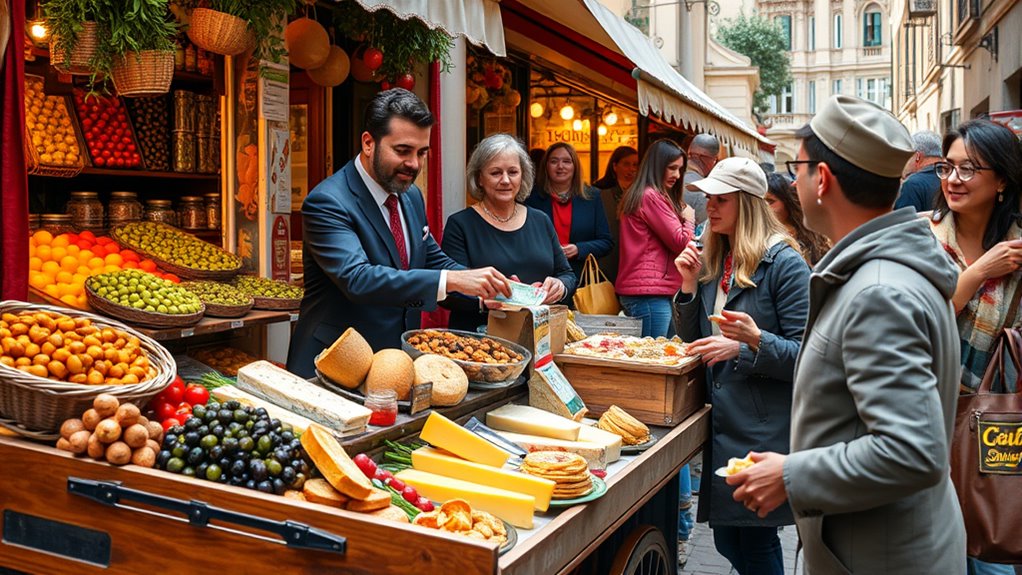
When paying at a market, it’s polite to ask whether they prefer cash or card first. Use friendly phrases like “Posso pagare con carta?” to show respect. Handling money with a smile and a simple “Grazie” makes the exchange courteous and smooth. Additionally, maintaining good user privacy during your interaction can help create a more positive and respectful atmosphere. Being aware of performance metrics such as the speed and efficiency of your transactions can also enhance the overall experience. Practicing self-awareness can help you gauge your comfort level and improve your interactions. Remember that a quick and respectful exchange can also act as a deterrent to potential security risks.
Cash and Card Use
Handling cash and cards politely is essential to making a good impression at Italian food markets. When paying, carry small bills and coins to facilitate smooth transactions. If you’re bargaining, be respectful and polite—this helps build good vendor relationships and shows your appreciation for their work. Many vendors prefer cash, but cards are increasingly accepted, especially in larger markets. When paying with a card, use contactless methods if available, and always confirm the amount before approving the payment. Avoid rushing or appearing impatient; patience fosters trust and good rapport. Remember, a friendly attitude combined with respectful handling of money makes your shopping experience more enjoyable and helps maintain positive interactions with vendors. Being aware of payment etiquette can further enhance your experience and ensure smooth transactions. Additionally, understanding payment methods can help you adapt to different vendors’ preferences and avoid misunderstandings. Demonstrating cultural sensitivity in your transactions can significantly improve your overall experience and relationships with local vendors. Recognizing local currency handling practices can also contribute to more seamless exchanges and demonstrate respect for local customs. Being attentive to vendor preferences can create a more positive shopping environment and foster goodwill.
Polite Payment Phrases
Using polite payment phrases can make your transactions smoother and more respectful. When paying at Italian food markets, it’s helpful to use phrases like “Il conto, per favore” (The bill, please) or “Posso pagare con carta?” (Can I pay with card?). Though tipping customs are modest, leaving a small tip or rounding up the total is appreciated. If you’re bargaining, do so politely and with a smile, respecting the seller’s cues. Avoid pressing for discounts or showing impatience. Using courteous language shows appreciation for the vendor’s effort and fosters goodwill. Remember, Italians value respectful interactions, so a simple “Grazie” (Thank you) after paying leaves a positive impression and encourages friendly exchanges. Incorporating digital menu solutions can also streamline your ordering and payment process, making interactions even more efficient. Being aware of cultural customs enhances your overall experience and helps build positive rapport with local vendors. Additionally, understanding emotional support principles can help you navigate any unexpected challenges during your shopping experience with patience and kindness.
Recognizing Authentic Italian Products
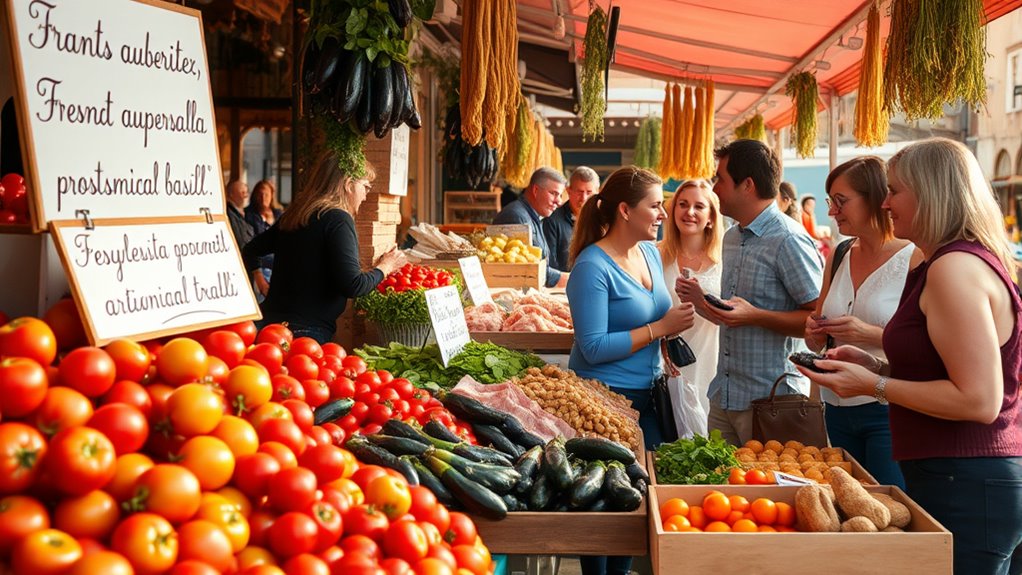
When shopping at Italian markets, look for authenticity indicators like labels, regional markings, and traditional packaging. These details help you identify genuine products and avoid imitations. Keep in mind that regional specialties often have unique qualities that reflect their local origins.
Authenticity Indicators
To guarantee you’re getting authentic Italian products, look for clear labels and certifications that guarantee quality. Authentic items often feature well-maintained market signage clarity, making it easier to identify genuine products. Pay attention to labels indicating PDO (Protected Designation of Origin) or PGI (Protected Geographical Indication), which certify authenticity. Building good relationships with local vendors can also help; they’re more likely to share insider knowledge about genuine products. Trustworthy vendors typically display consistent quality and are transparent about sourcing. Avoid products with vague or inconsistent labeling. Remember, genuine Italian products often carry recognizable certifications and are supported by a history of honest local vendor relationships. These indicators help ensure you’re purchasing authentic, high-quality Italian foods.
Regional Specialties
Authentic Italian products often carry distinctive regional markers that set them apart from imitations. Recognizing these signs helps you appreciate local culinary traditions and guarantees you’re getting genuine items. In regional markets, you’ll notice unique packaging, labels, or specific origins that highlight where the product comes from. Pay attention to regional market layouts, which often group specialties by area, making it easier to identify regional delicacies. For example, in Emilia-Romagna, you’ll find balsamic vinegar and Parmigiano-Reggiano, while Sicily offers cannoli and caponata. Learning these regional markers not only secures authenticity but also deepens your understanding of Italy’s diverse food culture. By observing these details, you can confidently select products that truly represent Italy’s rich culinary heritage.
Must-Try Snacks You Can’t Miss in Markets
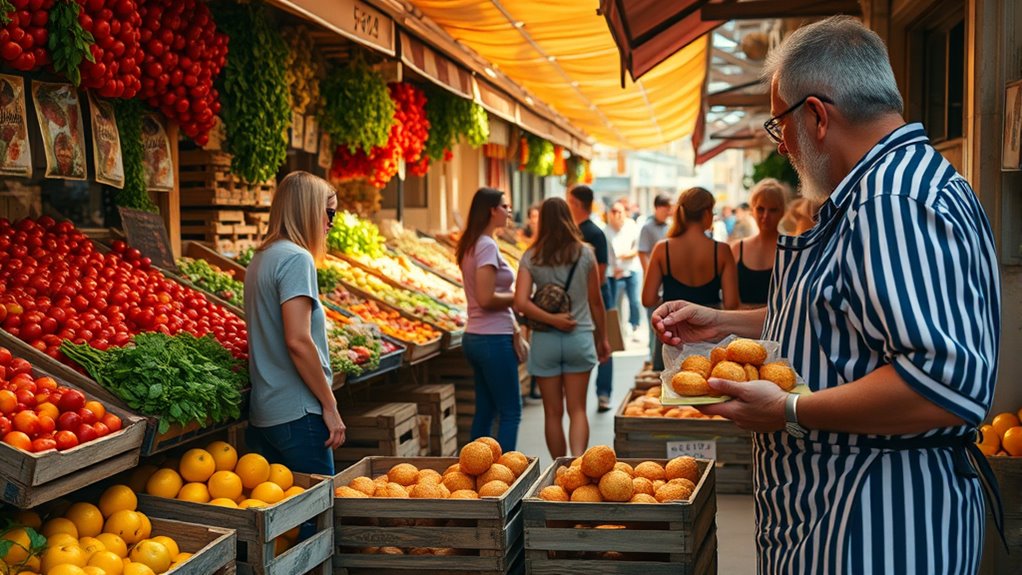
Italian food markets are bursting with irresistible snacks that you simply can’t leave without trying. Your snack selection offers a delightful variety of flavor profiles, from crispy fried treats to savory bites. Be sure to sample fresh arancini—golden rice balls filled with cheese or ragù—that deliver a satisfying crunch and rich taste. Another must-try is focaccia, topped with herbs and olive oil, perfect for a quick nibble. Don’t miss crispy panelle, chickpea fritters with a delicate, savory flavor. For a sweet option, try cannoli filled with sweet ricotta and candied fruit. These snacks showcase the diverse flavors and textures Italy’s markets have to offer, making every visit an exciting culinary adventure you won’t forget.
Do’s and Don’ts When Picking Fresh Produce

When selecting fresh produce, make certain to handle items gently and avoid squeezing or damaging them. Be respectful of the vendor’s space by observing sampling rules and asking permission before trying samples. Keeping these etiquette tips in mind helps ensure a smooth and enjoyable shopping experience.
Respect Produce Handling
To show respect for the vendors and the quality of the produce, it’s important to handle everything carefully when selecting items. Pay attention to produce presentation—look for vibrant colors, firm texture, and freshness. Gently touch or hold the fruits and vegetables, avoiding squeezing or dropping them, as this can damage the delicate produce. During vendor interaction, ask questions politely if you’re unsure about ripeness or best uses, but avoid grabbing items without permission. Remember, vendors appreciate careful handling because it preserves the quality and appearance of their goods. By being mindful and respectful, you create a positive experience for both yourself and the vendors, ensuring you leave with the best produce and maintain good market etiquette.
Observe Sampling Rules
As you select produce at the market, observing proper sampling etiquette helps you make confident choices while respecting vendors’ space. Follow market stall etiquette by asking permission before tasting anything, and avoid touching multiple items at once. Use the small tasting cups or toothpicks provided if available, rather than your hands, to maintain hygiene. Refrain from sampling excessively or lingering at a stall, as it can delay others. Remember, sampling etiquette is about being courteous—sample only what you’re genuinely interested in buying. If unsure about a fruit or vegetable, ask the vendor for guidance rather than guessing. By respecting these unspoken rules, you’ll enjoy the market experience and foster good relationships with local vendors.
Respecting Personal Space and Market Atmosphere
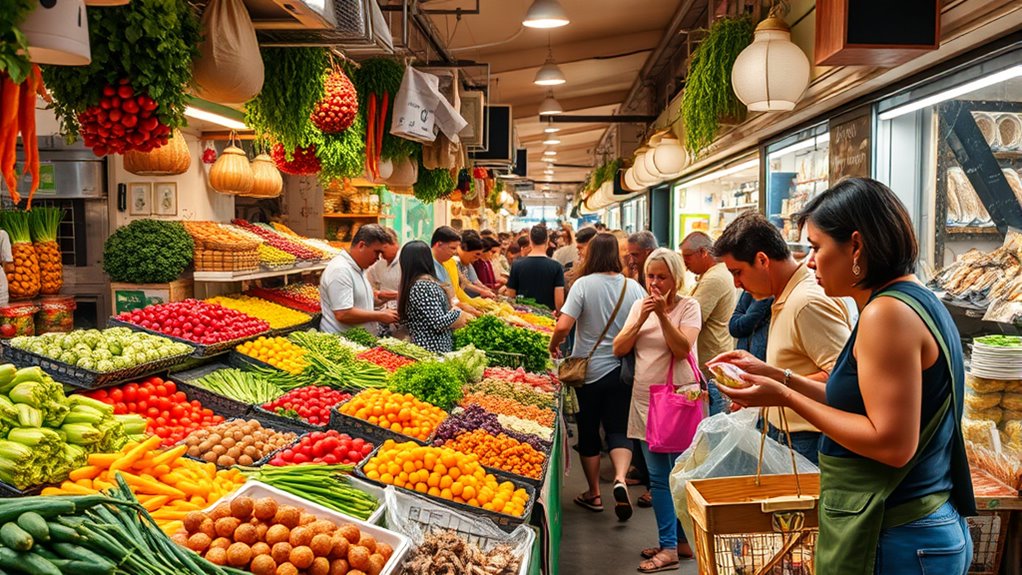
Respecting personal space and the lively atmosphere of Italian markets is essential for an enjoyable experience. Market noise can be loud, but it’s part of the authentic vibe, so stay attentive without raising your voice. When interacting with vendors, keep a respectful distance and be patient during busy times.
To help you navigate smoothly:
- Maintain a comfortable distance during vendor interactions, avoiding crowding.
- Be mindful of the market noise, speaking clearly but not loudly.
- Smile and make eye contact to foster friendly exchanges without invading personal space.
How to Store and Transport Your Purchases
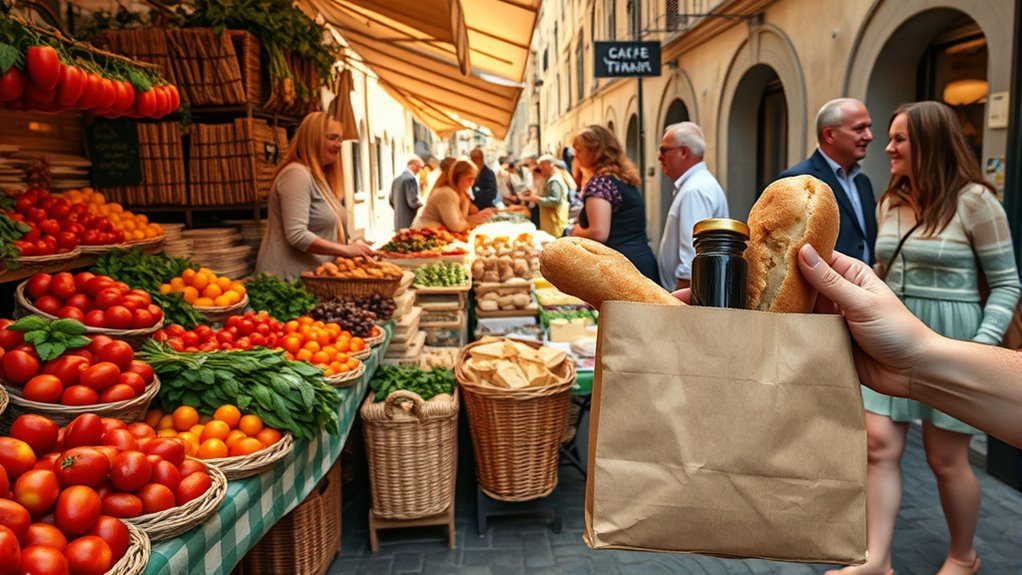
When shopping at Italian markets, knowing how to store and transport your purchases guarantees they stay fresh and intact. Practice good market stall etiquette by handling products carefully and asking vendors about the best storage methods. Clear vendor communication helps you understand whether items need refrigeration or special handling, especially for delicate produce or cheeses. Use sturdy bags or boxes to prevent squashing fragile goods like bread or pastries during transit. Keep perishable items chilled if you’ll be out for a while, and consider bringing an insulated bag for cheeses or meats. Pay attention to how vendors package items—they often have tips for maintaining freshness. Respecting stall etiquette and consulting vendors ensures your purchases remain in perfect condition until you get home.
Tips for Making the Most of Your Market Experience

To truly enjoy your time at Italian markets, take a moment to plan ahead. Familiarize yourself with local artisan crafts and sample snacks to deepen your experience. Here are three tips to maximize your visit:
- Engage with vendors respectfully, asking about their local artisan crafts and the story behind their products. This builds rapport and enriches your understanding.
- Follow market photography etiquette by asking permission before taking photos of vendors and their displays, especially of local artisan crafts. This shows respect and avoids misunderstandings.
- Keep an open mind and explore beyond your initial interests—sometimes the best finds are unexpected, and engaging with vendors often leads to tastings of unique snacks.
With these tips, your market experience will be more authentic and enjoyable.
Frequently Asked Questions
Are Tipping Customs Common in Italian Food Markets?
In Italian food markets, tipping customs are generally not common, especially for small purchases or bargaining etiquette. You usually pay the listed price, and vendors appreciate friendly interactions rather than tips. If you receive exceptional service or buy high-end products, a small tip or rounding up the amount is appreciated. Keep in mind, Italians value respectful bargaining etiquette, so negotiate politely without expecting large tips.
Can I Bargain Prices With Vendors in Italian Markets?
Bargaining in Italian markets is like dancing on a lively floor—you have to know the rhythm. While price negotiation isn’t always expected, in some markets, especially for larger purchases or fresh produce, friendly bargaining can be welcomed. Approach vendors politely, show genuine interest, and ask if there’s room for a better deal. Respect their response, and remember, a warm smile often opens doors better than words.
What Are the Best Times to Visit Markets for Fresh Produce?
You should visit Italian markets during the best morning hours, typically right when they open, to enjoy fresh produce at its peak. Weekday mornings usually see fewer crowds, so you can browse comfortably. Avoid peak weekday visits later in the day when vendors might be less enthusiastic to offer the freshest items. Early mornings guarantee the best selection and a more authentic experience, making your visit memorable.
How Do I Identify Seasonal or Regional Specialties?
Think of Italian markets as treasure chests filled with local specialties. To identify seasonal indicators, look for vibrant colors and freshness that match the time of year. Regional specialties often come with signs or labels highlighting their origin. Don’t hesitate to ask vendors about seasonal or regional favorites; they’re happy to share. Your keen eye and curiosity will help you uncover authentic tastes that define each region’s culinary identity.
Are There Specific Days When Markets Are Closed or Less Crowded?
You should verify market hours before visiting, as they can vary by day and season. Many markets open early and close by midday, especially on weekends. Be aware of holiday closures, when some markets may shut down entirely. To avoid crowds, try visiting on weekday mornings. Planning ahead guarantees you experience the freshest produce and avoid the busiest times, making your shopping more enjoyable and efficient.
Conclusion
As you wander Italy’s vibrant markets, you’ll find that a genuine smile and respectful gestures open doors to memorable connections—and perhaps even a secret recipe or two. Embrace the lively atmosphere, savor every taste, and trust your instincts. Sometimes, the simplest moment—sharing a laugh over a fresh piece of fruit—becomes a cherished memory. In these small exchanges, you’ll discover that the true essence of Italian markets isn’t just in the food, but in the stories you’ll carry home.









